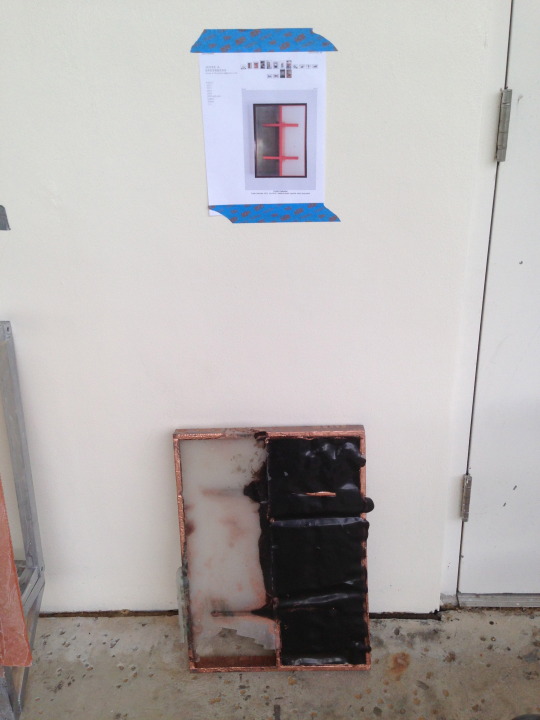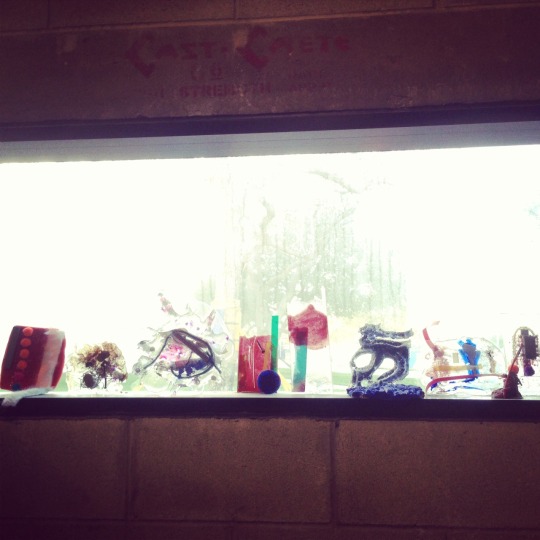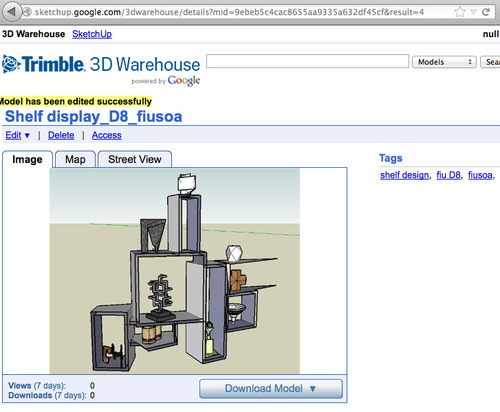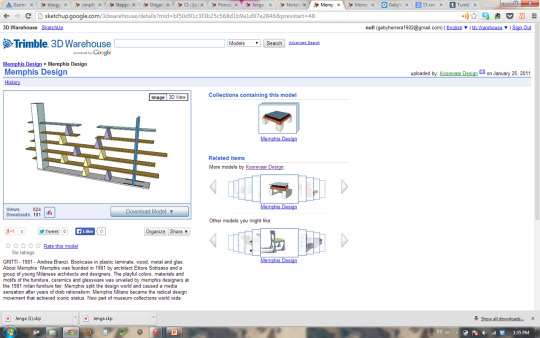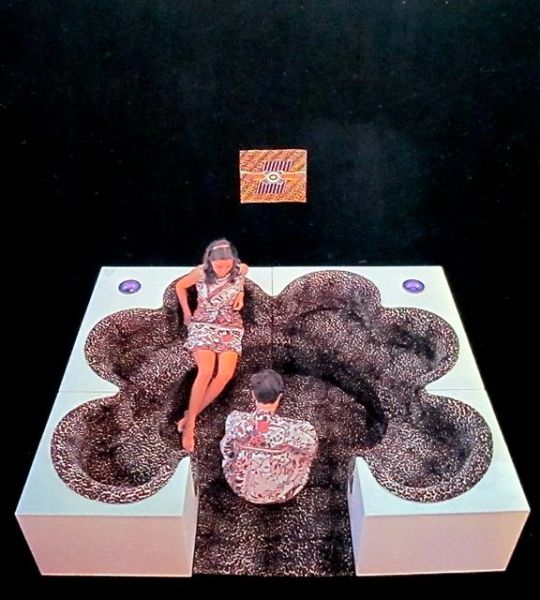Don't wanna be here? Send us removal request.
Text
Some Guiding Ideas
Jasper Johns
“Take an object. Do something to it. Do something else to it. (REPEAT) ”
Ettore Sottsass (in 1991 interview with Hans Ulrich Obrist)
However you look at it, I feel the task of the designer or the architect is to design the artificial environment, from objects to architecture, spaces, and so on. Each design corresponds directly or indirectly to an idea one has of life, of society, of the relations between the individual and society. It corresponds to the form of the weltanschauung [or worldview]; it remains the basic cultural background. And this happens in whatever you do. Whether I design a vase or design architecture, there is always this background, this basic cultural background.” Re-read the interview on the importance of understanding the inner essence of humanity in the era of globalization, on the inevitability of ‘progress’, and of “working on our micro-existence, on micro-gestures, micro-events,” [micro-situation] as perhaps the only realistic, attainable solutions one can offer
Yohji Yamamoto
“Start copying what you love. Copying, copying, copying. And at the end of the copy, you will find yourself.” Yohji Yamamoto via @kg_ubu Junkspace
Copy and Paste (OMA recycling)
“How to turn a Dutch house into a Portugese concert hall in under 2 weeks ”, RK, Content, 2004
Circulationism
In a recent essay Hito Steyerl focuses on the term circulationism as way of understanding the contemporary potential of art and the image. She suggests: "What the Soviet avant-garde of the twentieth century called productivism—the claim that art should enter production and the factory—could now be replaced by circulationism. Circulationism is not about the art of making an image, but of post-producing, launching, and accelerating it. It is about the public relations of images across social networks, about advertisement and alienation, and about being as suavely vacuous as possible."
Steyerl wonders what happens when the effects of digitisation slip off the screen and enter into the material world. What happens to our thought patterns, our language and our behaviour? Or even the weather, for that matter? In her opinion we have long since entered into a new paradigm—a space of no return—a free-flowing system of 'circulation' that circumscribes and influences everything from the government to love. Steyerl delves into these new conditions of circulationism and attempts to understand and reflect on its potential and impasses. Crucially, she remarks that circulationism, if reinvented, could also be about short-circuiting existing networks, circumventing and bypassing fixed regimes of power and money.
Reena Spaulings, a collectively-authored novel, 2005, Bernadette Corporation
“Reena Spaulings is a collectively-authored novel set in present-day New York. What is today? What is a city? These are two of the many questions this book sets out to ask. Like most novels, Reena Spaulings is a story about a twenty-something woman who works as a museum guard, is “discovered” and hired to model in an international advertising campaign, after which she gets fame and money, things change, the city experiences some very bad weather and strange new forms of social disobedience, and an idea is hatched to make a musical called “Battle Over Broadway,” a live song-and-dance-riot. It’s a story about a nobody who could be anybody becoming a somebody for everybody. It is a novel that tries to live the metropolitan life. Like Reena, the authors of this book are trying to live inside Reena Spaulings. Whatever is personal about their voices goes joyfully into the meticulous noise that is the collective music of this book. Like the book, whose authors are many and who abandon their identities to a common process, the New York City depicted herein tries to rethink itself as a collective experiment. Our lack of uniqueness, it seems to say, is the only thing we share today, besides our extreme separation. Reena Spaulings isn't the On The Road or The Great Gatsby of these times, which is to say that these times do not need or want those kinds of books. It is generic and perfect. It took less than three years to write. It is writing for everybody, by nobody, an overcrowded literary graveyard whose zombie author is called Bernadette Corporation.”
0 notes
Photo

Mobile and Flexible Environment Module, Ettore Sottsass, 1972
0 notes
Text
Spring Break Brief Due Friday 10pm
Due Friday 10pm
>Spring Break Brief
1. (5) points
Use the Artifact from team MonicaFiGabi to articulate (5) points of
description or characteristics you perceive (eg. material, phenomenal, perceptual, formal, etc…). Those five points need to be articulated verbally and visually (photo or sketch). Be precise about whether you’re responding to the physical artifact, the photo, your memory, or some combination.
2. List (3) conceptual interpretations of the above (eg. Monica and her liquid frame, or the inverted window structure)
3. Develop Window (or full-scale building component of your choice).
Choose one or more of the above conceptual interpretations to drive your ‘Window’ investigations. You can use someone else’s concepts of course, since no two results will be the same. You’re using the ‘Window’ to test out the concepts. As such, the building component, or the concept may have to alter to fully explore the idea.
a. Tell me what your component is
b. Tel me what concept(s) you intend to study.
These can change over the next few weeks, but you need to start with something intentional. I’ll advise if you need to modify the investigation.
Due Tuesday (Studio )
>Prototypes/Studies (5 minimum)
These should be real material or conceptual tests, which can be performed on a smaller scale, or in fragments. These should be more deliberate than the first resin tests, and still challenging and experimental.
> List
of materials, tools, files or steps you anticipate you’ll need to carry out projects over remaining part of the semester. And have adequate material and lab time scheduled for the week, so that you can jump into making.
We don’t have a lot of This can change, but you’ll lose out on shop and lab time if you don’t have an intent for the week. Note, for tools such as CNC and 3Dprinter, the sooner you can plan it out the more flexibility you’ll have to use them. We’re still scheduled to have our workshop with Peterson, but if we have enough files and materials ready, the work can be performed during the workshop.
Week 14 is finalization/outsourcing of project.
(calculate for any components that need to be sent out to fabricate).
Week 15 will be arranging, editing and setting up. (ie. no production)
>Read Junkspace (Under ‘Readings’ on ‘Resources’ page )
pull out at least (3) moments or ideas or questions in the essay that were resonant or revelatory for you. Do you read your surroundings differently? If this is a prevalent form of space making, what is the resistance to that kind of thinking? What does he mean by Junkspace? Do you agree or disagree? Give examples. Is this critical writing? Is it creative writing? why or why not? Is his tone pissed off? is it playful? Is it polemical? How do you resist or respond to this notion of Junkspace? Do you give up, negate, amplify, converse with it? Use OMA’s work to give examples to approaches.
0 notes
Text
A Sol Lewitt “Wall Drawing”
Sol Lewitt Wall Drawing (1974)
Now:
Execute this wall drawing on a sheet of 8.5×11″ (standard letter) paper. I recommend that you orient the paper in “landscape” orientation.
Please interpret “wall” as a 9″ (wide) x 6.5″ (high) rectangle centered on your page; thus, your sheet of paper with a 1″ border around it everywhere.
Please use pencil. It’s OK if you have visible guidelines, though they should be light.
Scan in your solution and embed it in a blog post.
Bring your paper solution to class; it will be pinned up and critiqued.
In a blog post of perhaps 100-150 words, briefly discuss your experience executing Sol Lewitt’s artwork. (Is this code?)
Label your blog post with the Category, Assignment-02-Lewitt.
2. Decoding Drawing
To find out which rules create this piece of art the first step is to view the picture analytically, then to word or set up the rules and finally to test the rules and iterate them.
//1 draw randomly three lines on a piece of paper, these lines should’t be parallel or a lead.
//2 repeat drawing randomly leads from all existing lines, the lines are not longer than the longest of the lines.
0 notes
Photo

geological window, primordial window, Fiorella Salamance
0 notes
Photo








workshop turrell window, Eduardo Garcia
color code, Marvin
camo grass, David Santana
touch screen, Monica Vazquez
David Rojas
Gabrielle
Nick Pendas
0 notes
Text
Assignment 6/7 - Window/Brick 02/18 - 2/25
For Tuesday: the following,
(3) Maquettes/Studies for ‘Window’ (bring to shop for discussion). (these are ‘Fast’ studies; in relation to the ‘Slower’ more thoughtful process of constructing the window for midterm.) Well developed concept and
Materials as needed to construct screens/armatures and some idea about process and planning your worktime in shop.
(10) Image grabs of textile/screens/window/material/whatever that’s influencing/inspiring/informing project, and post to tumblr and/or bring to shop. ( I’ll be posting the objects that I showed thurs. for your use as well.)
Research Vacuum Forming and CNC milling and bring (3) concrete ideas about how to use cnc and/or vacuum form as relates to the window and/or brick project. (can relate to technique, concept or material testing. use your imagination). I have several links on website under resources and assignments. That could be a start.
Workshop with Prof. Peterson re. CNC mill and Vacuum Former 5:00-7:00 (bring sketchbook and ideas/sketches)
For Tuesday the focus should be on Window assemblies and they should be well-developed in concept and model; as well as under way in terms of materials and construction.
I. Window Assemblies:
a.) Screens/Panels, think in terms of textiles, information, computer and device screens; as well as issues of inside/outside; transparencies/opacities; reflection, gradients, weaving, layering, thresholds, process, memory, etc. Positioning of windows within windows, or screens beyond screens, and various forms of information layered, as well as the relationship to the viewer/user; are also possible situations to consider.
b.) Armature, what’s the nature of the frame(s); How does it attach to space (eg. is it on floor, or wall, or corner? ) does it sit or hang or bolt. How are the panels and screens attached? Where do they sit in the frame, in relation to each other? What’s the relation of the screen to the armature – do they read as separate or related systems.
Keep in mind 'Window' is an assembly, a translation that should read as a whole as well as its parts. Use at least two things from a colleague. And Incorporate at least 2 found objects/parts – can be anything from ready-made brackets, angles, pallets, to bicycle parts, furniture pieces, etc. use your imagination. You will need to invest some degree of cost and time to construct something thoughtful.
II. Brick/Block Variations: You can be conceptualizing your brick/block as iteration or variation of a concept, or found object/process. They should be considered and ideas brought Tuesday to discuss with Peterson -- concepts and experiments still need planning or intent to achieve best results. You should pour or form any of the remaining tests you have this weekend. If the’y’re fully dry for Tuesday we may be able to test them with Peterson.
0 notes
Text
Assignment 5 - Lossy (Iterative Casts) 02/11, 02/13
The poor image is a copy in motion. Its quality is bad, its resolution substandard. As it accelerates, it deteriorates. It is a ghost of an image, a preview, a thumbnail, an errant idea, an iterant image that is distributed for free, squeezed through slow digital connections, compressed, reproduced, ripped, remixed, as well as copied and pasted into other channels of distribution…
-Hito Steyerl, In Defense of the Poor Image
“Traditionally used to refer to the degradation of an image when compressed as a digital JPG file, ‘lossy’ is a state in which digital information is discarded for the sake of file size. Resolution is lost, detail is changed, and fineness compromised. In this process, however, extra pixels may also be added, ultimately transforming and re-authoring the resulting Doppelganger image.”
What if the project is about “flipping the ‘loss’ of original resolution from being a negative condition into a potentially generative one. What kind of transformation might occur when switching an image into an object or the virtual into the real, the original into the cast copy and the invisible into the tangible. Perhaps this new, degraded ‘unoriginal; has much more to say by way of introducing poetic narrative, speculative fiction and alternative readings than the predecessor.”
For Tuesday you will build 5 forms and cast 1 of them, as well as have materials ready in studio.
The formwork itself will require you to think in inverse, as part of the process of re-creating an object – please bring the sketches and sections you’ve made to figure out your casts. See below for subject of cast.
A. Deliverables (Tues. Feb.11):
(5) Forms – @ 8”x10”x4” interior. See below for subject of cast. Be prepared to modify as needed in studio.
(1) Cast – at least one of the forms should be cast and pulled from form before studio Tuesday. (so that you have a sense of material quantities, timing of layering, construction of voids, etc.)
Materials (see below)
Narrative/Intent statement for each formwork
Reading (Optional): Breaking the Curve
B. Subject: You have the choice to re-scale and translate the shelf you designed, or a colleagues’ shelf structure, via cast construction. Or, you can pick one of the following objects to reconstruct as a cast:
a.) Voxel, or portion thereof: http://www.michael-hansmeyer.com/projects/voxels_info.html?screenSize=1&color=1
b.) Platonic Solids, subdivided, or portion thereof: http://www.michael-hansmeyer.com/projects/platonic_solids_info2.html?screenSize=1&color=1#undefined
c.) Column, subdivided, portion thereof http://www.michael-hansmeyer.com/projects/columns_info3.html?screenSize=1&color=1#undefined
C. Rules/Guidelines:
Traces of at least 2 planes of the formwork must be present as part of the final cast.
Interior of formwork must be 8” x 10” x 4” – which you will then build into and shape as needed.
At least 30% of the cast should be void
Additives (such as wood, steel, or fiber reinformcment) may be used to provide structure, support, or framework where needed or desired.
Layerings/Additives such as pigment, sand, tile, plexi etc. may be used to explore material, texture, translucency. Each of these studies should be a separate cast.
Note that resolution of original object will have to be modified. How you choose to edit and extrapolate the original object is part of the problem (for example, you will have to scale down the shelf, and you may also have to choose to construct a particular fragment or region of the shelf (If choosing only a portion, it must be a critical moment that displays a network of joints or spaces, or explores key concepts)
You must cast and remove at least one of the forms by 2pm studio time, and be prepared to modify your remaining forms as necessary.
D. Additional Notes:
I’ll be grading next week and presenting you with grade status up to now. Failure to complete assignment, including having materials prepared will reduce grade, as well as failure to complete and submit previous assignments.
If you don’t know how to do something, look it up and do it to the best of your ability. ‘Failures’ and mistakes are part of the process and should be included in the work you bring to studio.
E. Supplies/Sources
-Casting Material: At least one of the following plasters -- Plaster of Paris, Hydro-cal, Tuf-Cal. you should pool resources and purchase these in min. 25lb. bags per 2-3 persons. Wax/Soap/Acrylic mix is also acceptable. For plasters, best if you purchase at least two different types of plaster to test differences. (See below for some idea on pricing)
-Additives: plastic urethane, epoxy resin, sand, sticks, metal rods or brackets, fibers, paint (acrylic or enamel), old study models, etc.
-Mixing Supplies: measuring spoons or cups, mixing buckets, gloves, etc.
-Tutorials: YouTube, Instructables, etc. for form-building per material; casting of specific materials
-Selected material pricing (Suggestions only. Research accordingly to get the materials required) hydrocal 58$ 25 lb / 40$ 40lb; plaster of paris 16$ 25 lb; tuf-cal 46$ 100 lb
http://www.usg.com/content/usgcom/en/products-solutions/products/industrial-specialty/art-&-statuary/tufcalcastingstatuaryplaster.html
SilMar41 + extra composites. http://www.uscomposites.com You’ll buy Silmar 41, it’s $35/gallon, http://www.shopmaninc.com/polyesters.html You should also buy extra activator – (too little and the resin won’t set ) It comes in tubes (ethyl ketone peroxide) at home depot, or US composites.
https://www.google.com/shopping/product/1661743382666963748?q=epoxy&safe=off&client=safari&rls=en&bav=on.2,or.r_cp.r_qf.&bvm=bv.60799247,d.eW0,pv.xjs.s.en_US.60Rsr1-mOJU.O&biw=1468&bih=808&tch=1&ech=1&psi=rFv0Upe_MtOpkAfzjIDwCg.1391745966220.3&ei=tVv0UvPSGcrVkQeFioCACg&ved=0CKoBEKkrMAI
0 notes
Link
0 notes
Photo

https://twitter.com/kg_ubu/status/426036615530971136
32 notes
·
View notes





